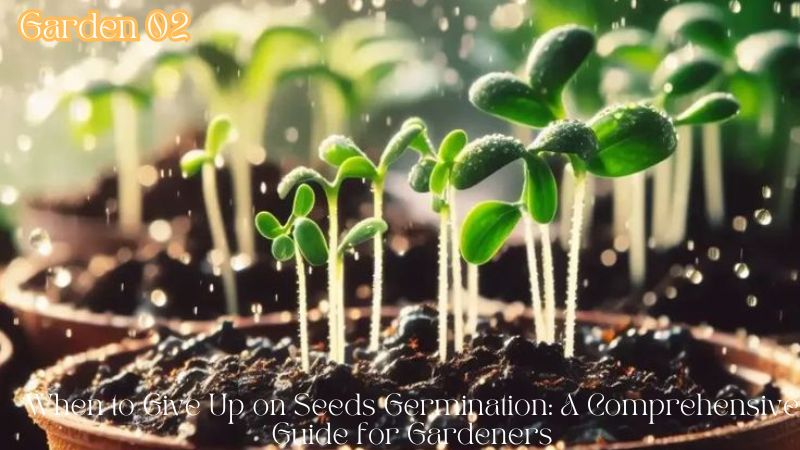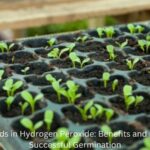Seeds and Germination
When to Give Up on Seeds Germination: A Comprehensive Guide for Gardeners
Growing plants from seeds is a satisfying yet sometimes challenging experience. Seed germination is a delicate process influenced by various factors, including moisture, light, temperature, and the quality of the seeds themselves. For those starting out or even seasoned gardeners, there can come a point when patience runs thin, and it feels unclear whether those seeds will ever sprout. Knowing When to Give Up on Seeds Germination is a skill that combines experience with knowledge of the ideal conditions each plant type requires.
This article Garden 02 delves into how to assess seed viability, factors affecting germination, troubleshooting techniques, and ultimately, how to know when to move on from a batch that’s not sprouting as expected.
Table of Contents
Toggle1. Understanding Seed Viability
Before sowing seeds, it’s essential to consider seed viability, which refers to a seed’s ability to germinate and grow. Seed viability is affected by:
- Seed age: Many seeds have an expiration period after which their germination rate decreases.
- Storage conditions: Temperature and humidity impact seed longevity. Proper storage in cool, dry conditions helps maintain seed viability.
- Seed quality: High-quality, disease-free seeds are more likely to germinate than low-quality or damaged seeds.
While it’s hard to predict with certainty if a seed will germinate, a few preparatory steps can help ensure you’re starting with the best possible chance of success.
2. Expected Germination Times for Common Plants
Each type of seed has an expected germination time. This timeline serves as a benchmark, allowing you to know when it’s reasonable to expect sprouts. Here’s an approximate guide for common plants:
- Vegetables:
- Tomato: 5-10 days
- Lettuce: 2-6 days
- Carrot: 10-20 days
- Pepper: 10-14 days
- Herbs:
- Basil: 5-10 days
- Mint: 12-15 days
- Rosemary: 14-21 days
- Thyme: 7-10 days
- Flowers:
- Marigold: 5-7 days
- Zinnia: 5-7 days
- Sunflower: 7-10 days
- Lavender: 14-28 days
Knowing these germination ranges is crucial; however, various conditions can cause delays.
3. Factors Affecting Germination
Even with healthy seeds, germination may not always go as planned. Here are some common factors that can prevent or delay seed sprouting:
3.1. Temperature
Each seed has an optimal temperature range for germination. Seeds planted in overly cold or hot environments may either delay germination or not sprout at all. Most vegetable seeds, for example, germinate best between 60-75°F (15-24°C). In cases of extreme cold, using a heating mat can help maintain consistent warmth.
3.2. Moisture Levels
Seeds require moisture to activate the enzymes responsible for growth. However, too much moisture can cause seeds to rot, while too little moisture can halt germination. Keeping the soil evenly moist but not soaked is key. Covering seed trays with a plastic dome or using a fine mist spray can help regulate moisture.
3.3. Light Requirements
Some seeds, like lettuce, need light to germinate, while others, like marigolds, germinate better in darkness. Understanding these requirements helps in providing the right conditions. It’s often beneficial to consult seed packets or reputable sources for specific light needs.
3.4. Soil Type and Depth
Planting seeds at the correct depth is critical. Shallow planting can dry seeds out, while planting too deep can prevent them from receiving enough light or oxygen. Loose, well-draining soil aids germination by allowing roots to penetrate easily.
3.5. Freshness and Quality of Seeds
Old or poorly stored seeds have lower germination rates. Performing a seed viability test, like the “float test” or the “paper towel test,” can give a rough idea of their potential.

4. Troubleshooting Common Germination Issues
When seeds don’t germinate within the expected time, troubleshoot before discarding them. Some common problems and solutions include:
4.1. Soil Dryness or Excessive Moisture
If seeds are drying out, place a plastic cover over the seed tray to create a mini greenhouse effect, ensuring moisture retention. If the soil is too wet, gently remove excess water and allow the soil to drain.
4.2. Inconsistent Temperatures
If temperatures fluctuate too much, consider relocating the seeds to a more stable environment. A grow light or heating mat may help, especially for seeds that require warmer conditions.
4.3. Pest or Mold Issues
Inspect your seeds and soil for signs of pests or mold. Fungus gnats, mold, or damping-off disease can all affect germination. Sterilizing soil before planting and using clean trays can help prevent these issues.
4.4. Testing Seed Viability with a Paper Towel
If you suspect low seed viability, place a few seeds on a damp paper towel, fold it, and place it in a plastic bag in a warm area. After a few days, check if any seeds sprout. This can help determine if the batch is worth planting.
5. Signs It May Be Time to Move On
If you’ve exhausted all troubleshooting options and seeds haven’t sprouted after a reasonable amount of time, it may be best to give up on that batch. Consider these indicators:
- Exceeding Double the Expected Germination Time: If it’s been twice the normal germination time (e.g., two weeks for lettuce, 40 days for carrots), the chances of sprouting decrease significantly.
- Seed Decay or Mold: If seeds start to break down, appear mushy, or develop mold, they’re unlikely to germinate.
- No Changes Despite Optimal Conditions: If you’ve provided ideal moisture, temperature, and light conditions, but there’s no sign of growth, seeds may lack viability.
6. Moving Forward with Fresh Seeds
If you decide to give up on a batch, don’t be discouraged. There are steps you can take to improve future germination success:
6.1. Purchase Quality Seeds
Choose reputable suppliers known for high-quality, fresh seeds. This minimizes the risk of purchasing old or poorly stored seeds.
6.2. Test Seed Viability in Small Batches
If you’re unsure about the quality of a particular seed batch, test a small sample using the paper towel method or a float test before planting larger quantities.
6.3. Pre-soak Seeds for Faster Germination
For hard-shelled seeds, soaking them in water for a few hours before planting can help speed up germination.
6.4. Maintain Ideal Conditions
Check the specific temperature, moisture, and light requirements for each plant type. Consistency is key to successful germination.
7. Alternatives for Difficult-to-Germinate Seeds
If certain seeds consistently fail to germinate, consider alternative approaches:
- Seedlings: Buying seedlings from nurseries or garden centers saves time and eliminates the uncertainty of germination.
- Pre-germinated Seeds: Some suppliers offer pre-germinated seeds, which come with a higher success rate.
- Hydroponic Germination: For seeds that require high moisture levels, starting them in a hydroponic system may offer better results.
8. Embracing Patience and Learning from Experience
Gardening is a journey, and even experienced gardeners face the challenge of failed germination. If you find yourself growing impatient, remember that it’s a part of the learning process. Over time, you’ll develop an intuitive sense for when to persist and when to start anew.
9. Conclusion
Knowing when to give up on seed germination is part science, part intuition, and part experience. Factors like seed quality, soil conditions, moisture, and temperature all play a role in germination success. By understanding these variables, troubleshooting common issues, and learning when to move on, you can make more informed decisions and increase your success in future plantings. Embrace each germination attempt as a step toward becoming a more knowledgeable and resilient gardener, even if some seeds simply weren’t meant to sprout.





